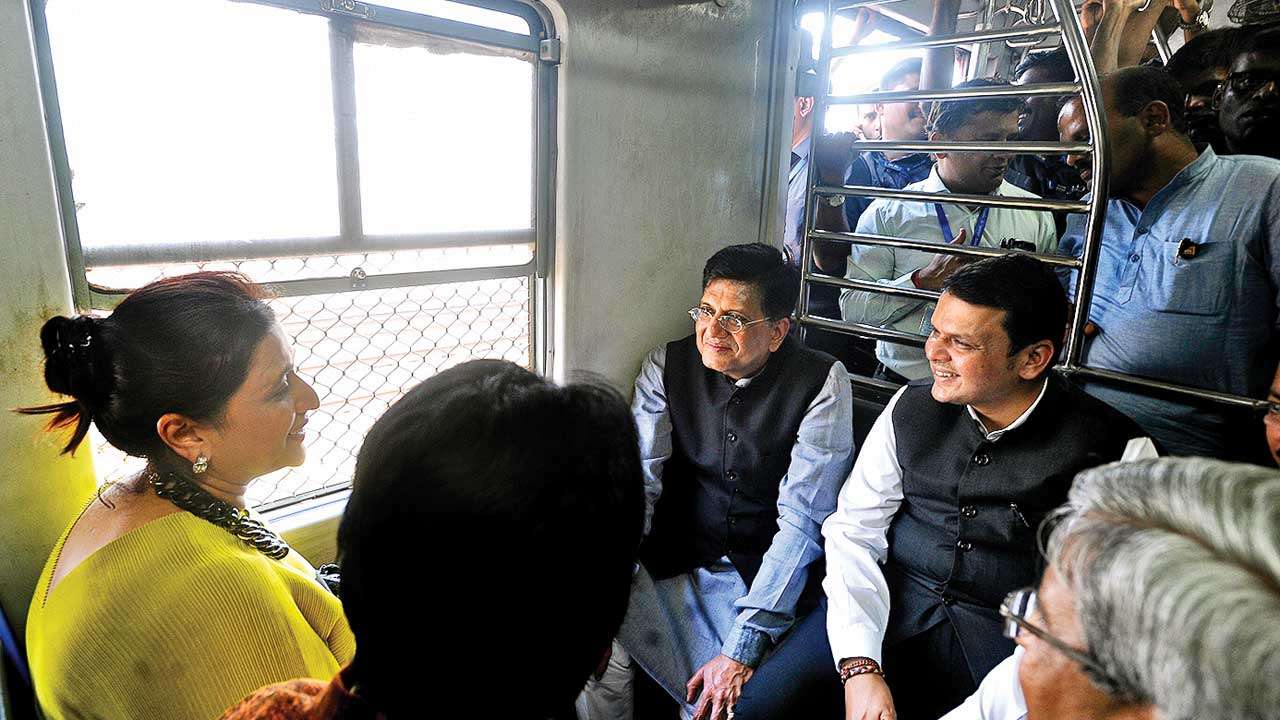
Modi govt@4: from bullet train to ac local, railways powers to an upgrade
- Select a language for the TTS:
- UK English Female
- UK English Male
- US English Female
- US English Male
- Australian Female
- Australian Male
- Language selected: (auto detect) - EN
Play all audios:
Minister Piyush Goyal, who himself has 4.3 million followers, has made it mandatory for every head of department to have a Twitter account to respond to the people Railway Minister Piyush
Goyal, his wife, and Maharashtra Chief Minister Devendra Fadnavis ride a local in Mumbai in February earlier this year In the four years of Modi government, the Indian Railways saw two
ministers leading the national transporter. The incumbent, Piyush Goyal, is focusing on improving safety and transforming railway stations; his predecessor Suresh Prabhu put in place a
robust feedback system by encouraging dialogues with passnegers on Twitter. Here's a brief look at the how the railways, with its track length of 67,368 km, which ferries 8,116 million
passengers a year, is pulling itself up by the bootstraps. MODERNISATION * REDEVELOPMENT OF STATIONS: Initial work on the revamp of 100-plus stations across India has begun at a cost of over
Rs 1.10 lakh crore. These stations will connect multiple modes of transport and eliminate food stalls on platforms among other things. The office buildings on the stations are set to rise
vertically. Over 700 stations will be revamped in the coming 10 years, and 675 have WiFi. * ESCALATORS: Many foot overbridges (FOBs) are under construction. The railways have also started
providing escalators at major terminuses. * LEVERAGING SOCIAL MEDIA: The Rail Minister directly responds to lakhs of people through social media. People, without hesitation, state their
problems directly to the ministry's Twitter handle, which has 3.3 million followers. Minister Piyush Goyal, who himself has 4.3 million followers, has made it mandatory for every head
of department to have a Twitter account to respond to the people. CLEANLINESS, HYGIENE: * MECHANISED CLEANING: Heavy duty machines, such as high pressure jet cleaners, floor scrubbers, and
vacuum cleaners, are deployed for cleaning coaches at depots through professional agencies. There is also the 'Clean Train Station' scheme under which trains passing through are
cleaned during their halts at 39 stations. * ONBOARD HOUSEHEEPING: This has been started in all Rajdhani, Shatabdi, Duronto and other key long-distance trains while they are in motion. The
scheme has been implemented on 864 pairs of trains until 2016-17. In addition, mechanised laundries are being set up for washing linen every month. The railways are also using CCTVs to
monitor cleanliness at stations. TOP TRAINS IN LAST 4 YRS * BULLET TRAIN: The high-speed rail line between Mumbai and Ahmedabad will catapult India in the big league. The train, which is
estimated to cost Rs 1.08 lakh crore will go underwater, underground and at an elevation, along its 508 km route. It will ideally be ready by 2021-22. * AC LOCALS: Demand for these Mumbai
locals is surging, with 10 lakh people having used the first one already in five months. As per plans, 12 more AC locals will start from October. The railways are also working on combining
non AC with AC coaches for Mumba's suburban trains. * GATIMAAN EXPRESS: This is India's first semi-high-speed train, from Delhi to Agra. It touches 160 kmph with ease. It has
received tremendous response. * TEJAS EXPRESS: This train which service the popular Mumbai-Goa route has changed the travel experience. It was the first train to have entertainment systems
found in international flights. But the amenity had to be removed after instances of passengers damaging the screens. * TRAINS FOR ALL: Even the poorest of the poor can afford train
travel in India with trains like Antyodaya Express and Deen Dayalu unreserved coaches. These trains have cushioned seats, mobile charging points, bio-toilets, CCTVs and smoke detectors.
VITAL SAFETY MEASURES Over the last four years, the number of accidents have seen a small decline. Train accidents per million train kms dropped from 0.10 in 2015-16 to 0.09 in 2016-17. Rail
officials said they have taken several measures to ensure that derailments and collisions do not occur. The recent case in Khushinagar, where 13 schoolchildren died, happened when their bus
driver paid no heed to the incoming train and crossed a level-crossing gate. In Mumbai, the railways are working on building 10-ft-high concrete walls along a 17.5-km stretch to check
trespassers. An advance warning system based on GPS has been installed at level-crossing gates to pre-warn road users of approaching trains. A software called Train Collision Avoidance
System has been installed in rakes, allowing them to brake automatically if a red signal is breached. To minimise human error, in 2016-17, the railways gave refresher training to 1.05 lakh
employees. For safer train movement multi-aspect colour signals have been set up at 5,584 stations. The railways has constructed several foot overbridges, subways and road overbridges along
rail tracks for passenger safety. In Mumbai, over 70 FOBs have or will be made available for 80 lakh daily suburban commuters.